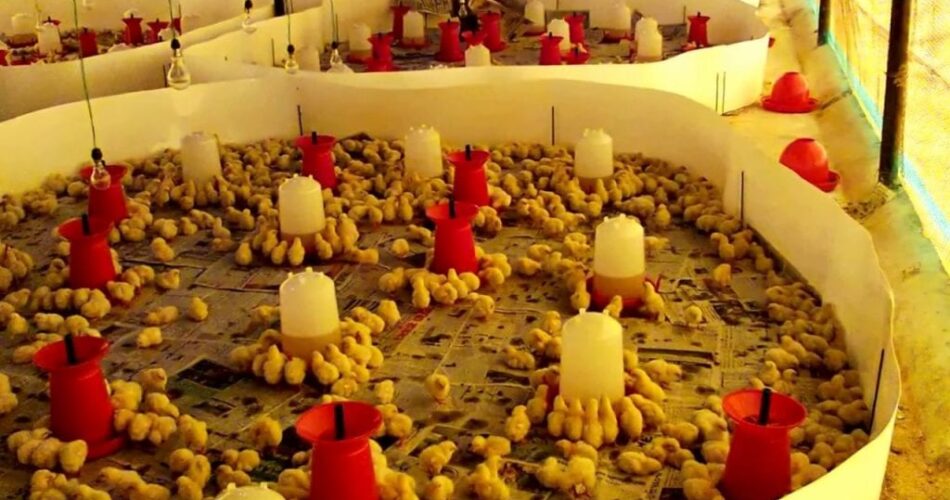Brooding is the process of keeping young chicks warm so that good health and optimum performance can be achieved. Brooding is necessary for 4 weeks from hatch.
The purpose of brooding is to maintain a suitable environmental temperature and humidity to support the health, performance and survival of the chicks. Since poultry produce body heat by converting energy into heat, it is important to supply additional energy in the form of feed and water to supply enough energy for growth as well as heat production.
Brooding is the process of keeping young chicks warm so that good health and optimum performance can be achieved. Brooding is necessary for 4 weeks from hatch.
Brooding is the process of keeping young chicks warm so that good health and optimum performance can be achieved. Brooding is necessary for 4 weeks from hatch, and is an important process to maintaining a healthy flock. Chicks should be kept at a temperature of 90-95 degrees F, with humidity at 50-55%. This can easily be accomplished by using brooder heaters or infrared bulbs to raise the temperature in your brooder area, while keeping the rest of your house cooler.
The purpose of brooding is to maintain a suitable environmental temperature and humidity to support the health, performance and survival of the chicks.
Brooding is the process of keeping chicks warm, comfortable and safe. Chickens and other poultry require a constant temperature for at least 2-3 weeks in order to keep them healthy, although this time frame varies depending on the species. Once the birds have warmed up, it takes about 1 week for maintenance heating requirements to become stabilized.
Since poultry produce body heat by converting energy into heat, it is important to supply additional energy in the form of feed and water to supply enough energy for growth as well as heat production.
Since poultry produce body heat by converting energy into heat, it is important to supply additional energy in the form of feed and water to supply enough energy for growth as well as heat production.
Feeding and watering brooding chicks are different from feeding adult chickens that have already been fully grown, which means they will require more food per pound than adults. By providing extra food in the form of chick starter crumbles or grower rations (depending on your age), you can ensure that your chicks are getting enough nourishment for growth as well as their body temperature regulation needs.
When chicks are placed on the floor, they instinctively move away from the cold and crowded together in one warm area which is termed as “heat” or “brood” area.
When chicks are placed on the floor, they instinctively move away from the cold and crowded together in one warm area which is termed as “heat” or “brood” area.
They move towards warmth, light and feed.
The chicks instinctively move to a place where food is available.
This behavior helps regulate their body temperatures and conserve energy required to maintain homeostasis.
Chickens need an incubator that can maintain a temperature of at least 104 degrees Fahrenheit for the first 2-3 weeks of their lives. Chicks are unable to regulate their own body temperature, which makes them vulnerable to cold stress, so they must be kept warm for this period of time. If a chick’s body temperature drops below 98 degrees Fahrenheit, it is likely that he will die from cold stress or hypothermia if the problem is not corrected immediately.
Chickens kept at warm temperature need less feed than when maintained at lower temperature in order not only to maintain their body temperature but also for growth and development.
Chickens kept at warm temperature need less feed than when maintained at lower temperature in order not only to maintain their body temperature but also for growth and development.
The amount of feed required by chicks is directly related to their rate of growth. When kept at higher temperatures, the chickens are able to grow faster, which means they can be ready for market sooner. This increased rate of growth has been found in many studies as well as by practical experience.
Chicks need constant temperatures for at least 2-3 weeks, otherwise mortality will be high during this period. Once the birds have warmed up, it takes about 1 week for maintenance heating requirements to become stabilized.
Brooding is the process of keeping young chicks warm so that good health and optimum performance can be achieved. Brooding is necessary for 4 weeks from hatch, or 21 days in total. Chicks need constant temperatures for at least 2-3 weeks, otherwise mortality will be high during this period. Once the birds have warmed up, it takes about 1 week for maintenance heating requirements to become stabilized.
Brooding temperatures should be maintained between 95°F (35°C) and 100°F (38°C) during the first week and then reduced by 2° per week until 80°F (27°C) is reached by day 14-18 of age.
A brooding house has to be constructed such that it can maintain a constant temperature inside the house. Therefore, sufficient insulation should be provided in order to minimize heat loss from roof and walls. Furthermore, artificial heating may not be required for the last week of brooding period. However, if the air temperature falls below 15 °C, then artificial heating is required for about 4 weeks until birds are placed in their permanent houses.
